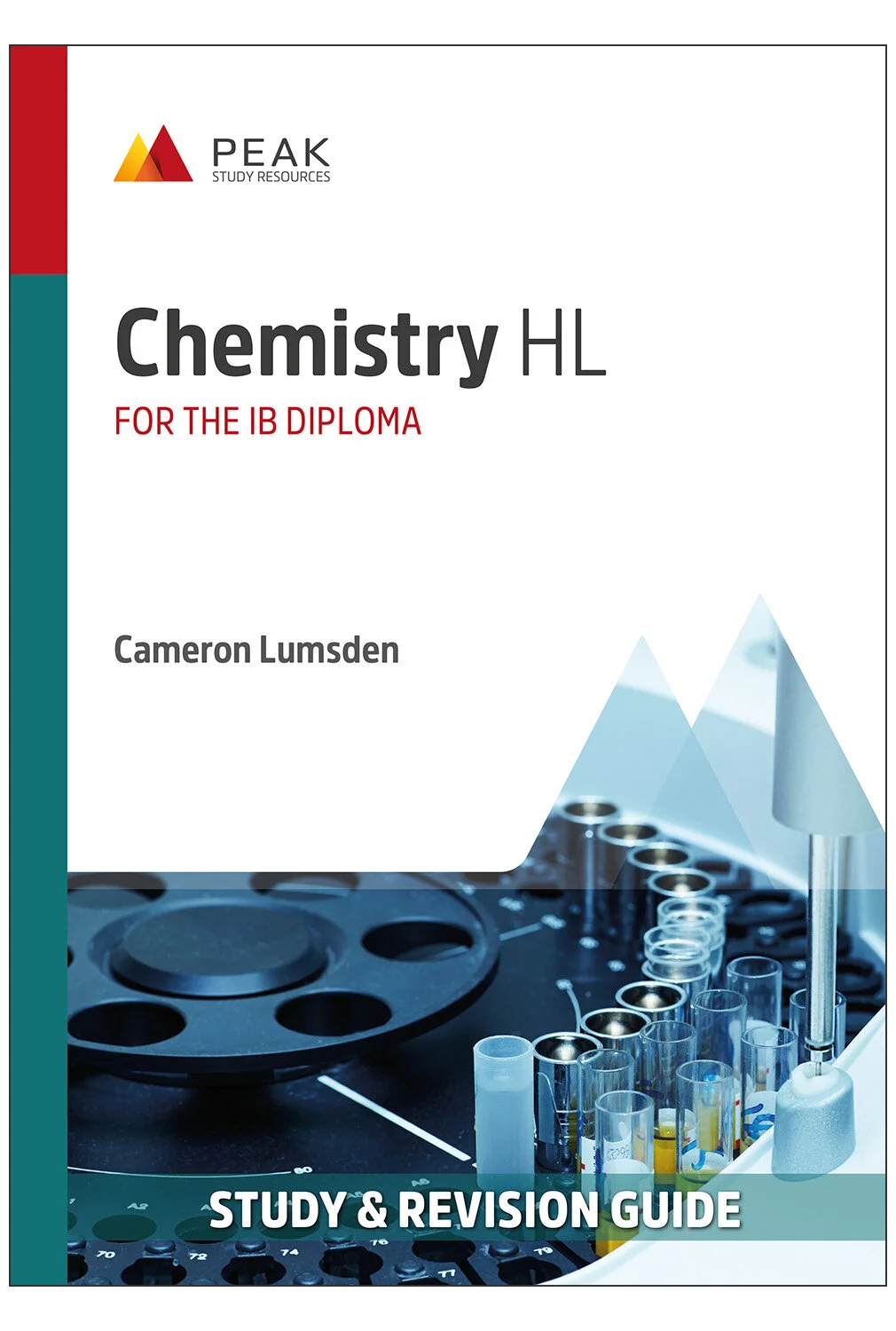Chemistry Standard Level


















Chemistry Standard Level
Cameron Lumsden
This IB Chemistry study guide for Standard Level students provides a comprehensive review of all core SL topics and shows how to apply that learning to each exam paper. With clear diagrams, practical hints, and plenty of practice questions, the guide will help you increase your understanding and build your confidence in advance of your IB exams.
We are currently supplying the OSC edition of this title:
ISBN: 9781910689011
163 pages
Key features of the Chemistry SL study guide:
A comprehensive IB Chemistry study guide for SL students, containing a review of all core topics written in an easy-to-follow manner.
Lots of practice questions including over 200 Learning Check questions to ensure you understand key concepts, plus 40 more exam-style questions to test your knowledge.
Common Mistake Labels drawing your attention to errors students often make in exams.
Definition Labels providing explanations of key terms.
Exam Hint Labels providing top tips for how to approach your IB Chemistry SL exam.
Clear diagrams illustrating key concepts that you will need to know and re-create for your exam.
Content of the Chemistry SL study guide:
Quantitative Chemistry
Mole Concept
Units
Mole – Particle Conversions
Molar Mass
Mole – Mass Conversions
Balancing Equations
Mole Relationships in a Chemical Reaction
Mass Relationships in a Chemical Reaction
Limiting Reactant
Determination of Formulae – Gravimetric Analysis
Mixtures & Solutions
Making Solutions and Determining Solute Mass
Kinetic Molecular Theory
Pressure
Boyle’s Law
Pressure Law
Charles’ Law
The Combined Gas Law
Avogadro’s Law
Avogadro’s Law of Combining Volumes
Ideal Gas Law
Yield: Theoretical, Experimental and Percentage
Empirical & Molecular Formulae
Calculations from Percentage Information
Calculations from Empirical Data
Compounds Containing Oxygen
Molecular Formula
Summary Questions
Atomic Structure
Subatomic Particles
The Nuclear Atom & Isotopes
Isotope Notation
The Mass Spectrometer
Relative Atomic Mass
Calculating Relative Average Atomic Mass
Calculating Natural Abundance
The Electronic Atom – Basic Structure
Evidence for Shells – The Hydrogen Spectrum
Explaining the Hydrogen Spectrum
The Electronic Atom – Shells & Sub-Shells
Summary Questions
Periodicity
Structure of the Periodic Table
Effective Nuclear Charge
Trends in the Periodic Table – The Basic Idea
Atomic Radius
Ionic Radius
Atomic vs. Ionic Radii
Ionization Energy – General Trend
Electron Affinity
Electronegativity
Chemical Properties
Reactions of Alkali Metals and Halogens
Reactions of Alkali Metals with Water
Properties of the Halogens
Halogens & Halides
Chemical Properties Across Period 3
Reactions of the Oxides of Period 3 with Water
Summary Questions
Bonding
Bonding vs. Structure
The Octet Rule
Types of Bonding
Ionic Charges & Formulae
Simple Ionic Compounds – From the Periodic Table
Transition Metal Compounds
Is it +2 or 2+?
Compounds of Polyatomic Ions
Ionic Compounds & Properties
Metallic Bonding & Alloys
Melting Point
Melting Point of Group 1 – The Alkali Metals
Covalent Bonding
Covalent Formulae
Lewis Structure
VSEPR Theory & Molecular Shapes I Resonance & Delocalization
Resonance Stabilization Energy
Bond Polarity and Molecular Polarity
Bond Length and Strength
Allotropes of Carbon
Intermolecular Forces
London Dispersion Forces
Dipole – Dipole Forces
Dipole – Induced Dipole
Hydrogen Bonding
The Layering of Intermolecular Forces
How do you Determine the type of IMF?
Types of Solids
Physical Properties of Solids
Summary Questions
Energetics
Endothermic & Exothermic
Potential Energy Diagrams (Enthalpy Diagrams)
Standard Conditions
Calorimetry – Enthalpy Change Calculations
Assumptions in Calorimetry
The Calorimeter Constant
Hess’ Law
Heat of Hydration
Bond Enthalpy
Standard Enthalpy Changes
Standard Enthalpy of Formation
Standard Enthalpy of Combustion
Which Formula do I use?
Summary Questions
Kinetics
Rates of Reaction
Rate Experiments
Collision Theory
Factors Affecting Rate of Reaction
Equilibrium
Dynamic Equilibrium
Approaching Equilibrium
Position of Equilibrium
LeChÂteleir’s Principle
Reaction Quotient
The Meaning of Kc
Determining the Equilibirum Constant, KEQ
Determining Equilibrium Concentrations
Summary Questions
Acids & Bases
Bronsted-Lowry Theory of Acids and Bases
Properties of Acids & Bases
H+ (AQ) or H3O+ (AQ)?
Conjugate Pairs
Amphoteric Substances
Strong & Weak
Distinguishing Between Strong and Weak
pH Scale
Acid Deposition
Buffer Solutions
Summary Questions
Oxidation & Reduction
Oxidation Numbers
Redox Reactions
Reactivity
Half Reactions
Dissolved Oxygen and BOD Definitions
Voltaic Cells
Salt Bridge
Standard Electrode Potentials
Electrolysis of Molten Salts
Electrolysis of Solutions
Factors Affecting Amount of Electrolysis Product
Balancing Redox Reactions in Acidic Solution
Summary Questions
Organic Chemistry
Hydrocarbons
Naming Hydrocarbons
Isomers
Structural Isomers
Branching in Organic Chemistry
Alkanes
Organic Functional Groups
Functional Groups vs. Classes of Compounds
Functional Group Isomerism
Alkenes – Electrophilic Addition Reactions
Benzene and Derivatives
Important Isomers
Halogenoalkanes
Nucleophilic Substitution Reactions
Alcohols
Combustion of Alcohols
Oxidation of Alcohols
Alcohol Oxidation Products
Reduction of Aldehydes, Ketones and Acids
Functional Groups Containing Nitrogen
Reduction of Nitriles
Ester Condensation Reactions
Reaction Pathways
Summary Questions
Measurement & Data Processing
Observations
Uncertainty in Measurements
Precision & Accuracy
Significant Digits
Rounding of Numbers
Adding and Subtracting Significant Digits
Multiplying and Dividing Significant Digits
Systematic Uncertainty
Absolute & Relative Uncertainty
Propagating Uncertainty
Types of Relationships
The Formula of a Compound
Mass Spectroscopy (MS)
Nuclear Magnetic Resonance
Infrared Spectroscopy
X-Ray Crystallography







